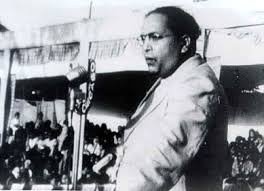Drafting Indias Constitution
Dr Bhimrao Ambedkar

Drafting Indias Constitution
Upon Indias Transfer of Power by British Government to leaders of High Cast on 15 August 1947, the new Congress led government invited Ambedkar to serve as the nations first Law Minister, which he accepted. On 29 August, he was appointed Chairman of the Constitution Drafting Committee, charged by the Assembly to write Indias new Constitution.Granville Austin has described the Indian Constitution drafted by Ambedkar as first and foremost a social document. The majority of Indias constitutional provisions are either directly arrived at furthering the aim of social revolution or attempt to foster this revolution by establishing conditions necessary for its achievement.
The text prepared by Ambedkar provided constitutional guarantees and protections for a wide range of civil liberties for individual citizens, including freedom of religion, the abolition of untouchability and the outlawing of all forms of discrimination. Ambedkar argued for extensive economic and social rights for women, and also won the Assemblys support for introducing a system of reservations of jobs in the civil services, schools and colleges for members of scheduled castes and scheduled tribes and Other Backward Class, a system akin to affirmative action. Indias lawmakers hoped to eradicate the socio economic inequalities and lack of opportunities for Indias depressed classes through these measures.The Constitution was adopted on 26 November 1949 by the Constituent Assembly.
Ambedkar resigned from the cabinet in 1951 following the stalling in parliament of his draft of the Hindu Code Bill, which sought to expound gender equality in the laws of inheritance and marriage. Ambedkar independently contested an election in 1952 to the lower house of parliament, the Lok Sabha, but was defeated in the Bombay (North Central) constituency by a little known Narayan Sadoba Kajrolkar, who polled 138137 votes compared to Ambedkars 123576 votes. He was appointed to the upper house, of parliament, the Rajya Sabha in March 1952 and would remain as member till death.
 Test your English Language
Test your English Language  Management Mantras
Management Mantras Benefits of Oranges
Benefits of Oranges Benefits of Elderberry
Benefits of Elderberry Valentines Day Chocolates Ideas
Valentines Day Chocolates Ideas Benefits of Pomelos
Benefits of Pomelos Crazy Facts
Crazy Facts Ebola Virus
Ebola Virus Economy of India
Economy of India




